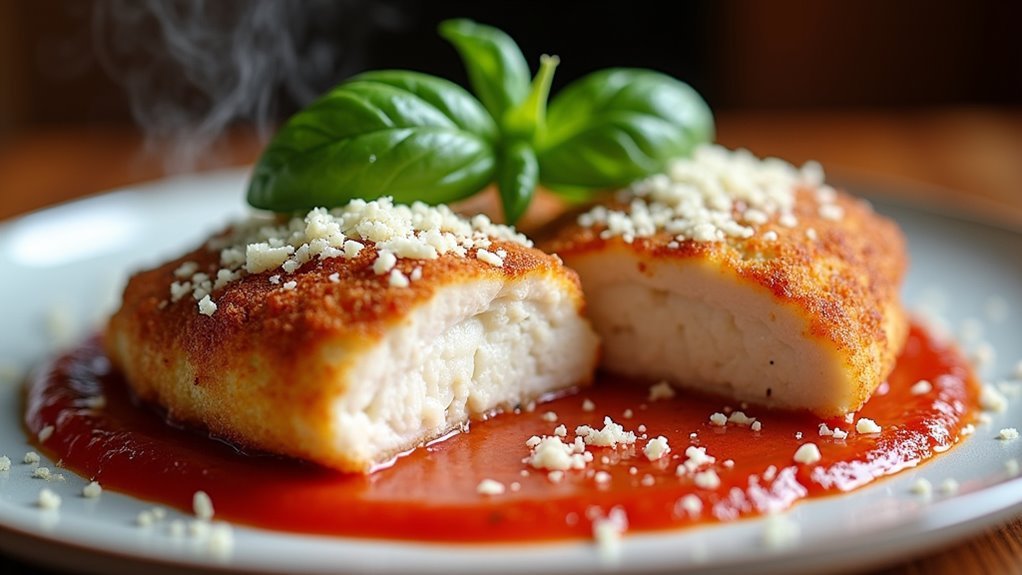Sous vide transforms chicken parmesan by cooking breasts at precisely 60°C/140°F for an hour, guaranteeing juicy meat throughout—something traditional methods often fail to deliver. After cooking, pat the chicken dry thoroughly before breading it with flour, egg, and breadcrumbs for that essential crispy exterior. The contrast between the moist, tender interior and golden crust makes this technique worth the extra effort. The combination of precise temperature control and proper finishing touches elevates this classic dish to restaurant quality.
Why Sous Vide Is the Secret to Juicy Chicken Parmesan

Although many traditional chicken parmesan recipes call for pan-frying or baking, sous vide cooking has revolutionized this classic Italian-American dish. The precise temperature control guarantees chicken remains perfectly juicy at 60C/140F while eliminating the common problem of dry, overcooked meat.
Sous vide brings perfect moisture to chicken parmesan where traditional methods often fall short.
What makes sous vide especially valuable for chicken parm is consistency. Every portion cooks evenly through to the center without sacrificing moisture.
I think this matters particularly when you’re adding the finishing touches – the breading and sauce shouldn’t have to compensate for already dried-out chicken.
Plus, there’s something wonderfully hands-off about the process. You can prepare sides while your chicken bathes to perfection. Additionally, the use of a vacuum sealer ensures that the chicken retains its natural juices during cooking, enhancing the overall flavor and texture.
Essential Equipment for Sous Vide Chicken Success
To achieve restaurant-quality sous vide chicken parmesan at home, proper equipment makes all the difference. While the technique itself is straightforward, having reliable tools guarantees consistent results every time. I think most home cooks underestimate how important the right gear can be.
For sous vide chicken success, three essentials stand out:
- A precise sous vide machine (Anova Precision Cooker or Breville Joule are excellent choices)
- A spacious container (12-quart Rubbermaid works perfectly)
- Proper sealing methods (vacuum sealer or water displacement technique)
Perhaps the container seems less critical, but it actually provides the stable environment needed for even cooking. An effective sealing method, such as a vacuum sealer with adjustable modes, can greatly enhance your food preservation efforts.
Step-by-Step Sous Vide Chicken Parmesan Method
Creating the perfect sous vide chicken parmesan involves a methodical process that yields consistently juicy results.
First, set the sous vide machine to exactly 60°C/140°F, which I think creates the ideal balance between safety and tenderness.
Temperature precision is the secret to sous vide perfection – 60°C/140°F delivers that magical balance of food safety and tender, juicy chicken.
Season chicken breasts with salt, then vacuum seal them or use the water displacement method if you’re without a vacuum sealer.
Submerge the sealed chicken in the water bath for about an hour.
After cooking, pat the chicken dry before adding more seasoning.
The final touches—dredging in flour, dipping in egg, coating with breadcrumbs, and shallow frying until golden—transform this juicy protein into a restaurant-worthy chicken parmesan. This precision cooking method leverages the vacuum sealing process which enhances flavors and preserves the quality of the meat.
Achieving That Perfect Golden Crust Finish

The golden crust factor makes or breaks a truly exceptional chicken parmesan. After the sous vide process guarantees perfectly juicy chicken, achieving that crispy exterior requires careful attention to detail.
Perhaps the most critical step is thoroughly patting the chicken dry before breading – any excess moisture will prevent proper browning.
For that restaurant-quality crust, follow these key steps:
- Use very hot oil – around 375°F is ideal for that quick sear
- Don’t crowd the pan – give each piece breathing room
- Let the breaded chicken rest for 5-10 minutes before frying to help coating adhere better. Additionally, utilizing vacuum sealing for meal prep can enhance your efficiency and help keep your chicken fresh for longer periods.
Frequently Asked Questions
Can I Use Frozen Chicken Breasts for Sous Vide Cooking?
Frozen chicken breasts work well for sous vide cooking. Users can add them directly to the water bath, simply extending the cooking time by 50% to guarantee thorough, safe cooking throughout.
How Long Does Sous Vide Chicken Parmesan Stay Fresh in Refrigerator?
Nearly 40% of home-cooked meals are wasted due to improper storage. Sous vide chicken parmesan stays fresh in the refrigerator for 3-4 days when stored in an airtight container.
Can I Prepare the Breading Mixture in Advance?
Yes, the breading mixture can be prepared in advance. It’s advisable to store dry ingredients separately from wet components until ready to use for ideal texture and adherence.
Is It Possible to Sous Vide Multiple Chicken Breasts Simultaneously?
Kill two birds with one stone by sous viding multiple chicken breasts simultaneously. The process works perfectly as long as the breasts are arranged in a single layer without overlapping.
What Wine Pairs Best With Sous Vide Chicken Parmesan?
For sous vide chicken parmesan, medium-bodied Italian red wines like Chianti or Sangiovese complement the dish beautifully. Pinot Noir offers a lighter alternative, while Chardonnay works well for white wine enthusiasts.
